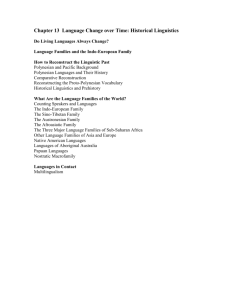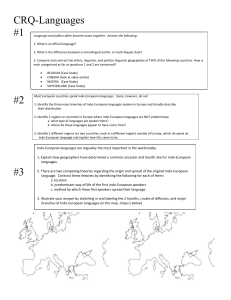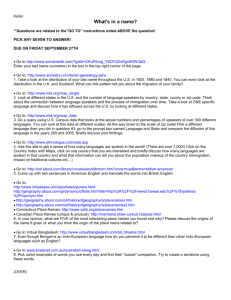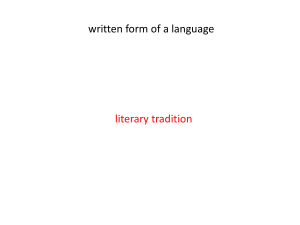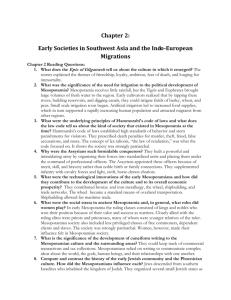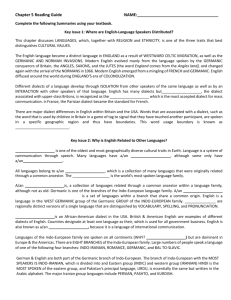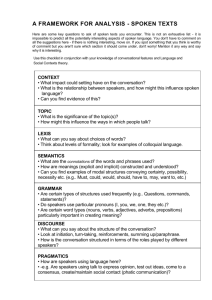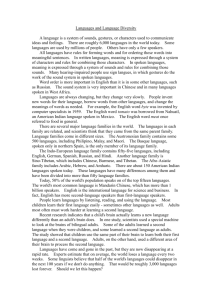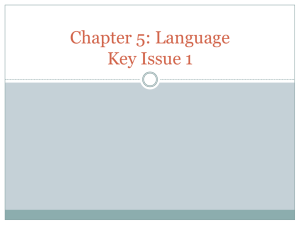Linguistic Culture Regions
advertisement
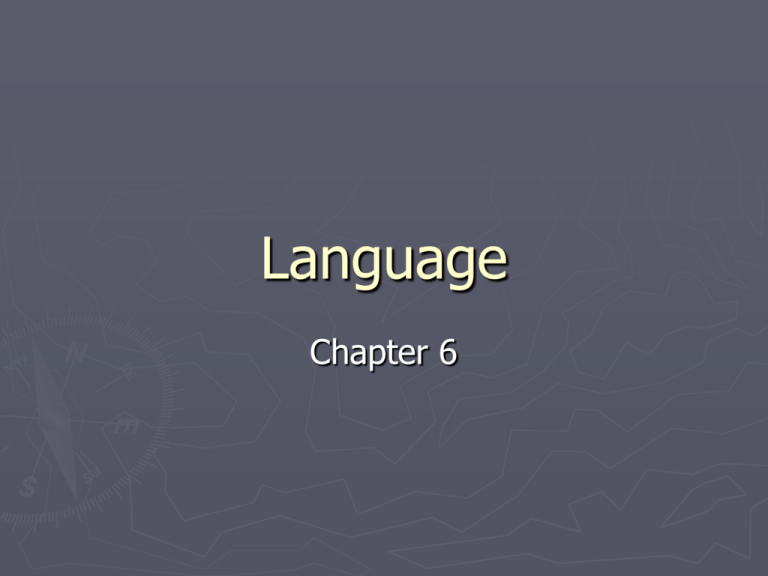
Language Chapter 6 Language Language – a set of sounds, combinations of sounds, and symbols that are used for communication. Mutual Intelligibility ► Means two people can understand each other when speaking. Problems: ►Cannot measure mutual intelligibility ►Many “languages” fail the test of mutual intelligibility ►Standard languages and governments impact what is a “language” and what is a “dialect” How Languages are Formed? ► Can find linkages among languages by examining sound shifts – a slight change in a word across languages over time. eg. Milk =lacte in Latin latta in Italian leche in Spanish lait in French How are Languages Formed? ► Language divergence – when a lack of spatial interaction among speakers of a language breaks the language into dialects and then new languages. ► Language convergence – when peoples with different languages have consistent spatial interaction and their languages collapse into one. Monolingual State a country in which only one language is spoken Multilingual State a country in which more than one language is in use Official Language should a multilingual state adopt an official language? Dialect variants of a standard language along regional or ethnic lines - vocabulary -syntax - pronunciation - cadence - pace of speech Isogloss A geographic boundary within which a particular linguistic feature occurs How do Linguists Study Historical Languages? ► Backward reconstruction – tracking sound shifts and the hardening of consonants backward to reveal an “original” language. Can deduce the vocabulary of an extinct language. Can recreate ancient languages (deep reconstruction) Language and Cultural Identity Language and Culture “No one was allowed to speak the language – the Dena’ina language. They [the American government] didn’t allow it in the schools, and a lot of the women had married non-native men, and the men said, ‘You’re American now so you can’t speak the language.’ So, we became invisible in the community. Invisible to each other. And, then, because we couldn’t speak the language – what happens when you can’t speak your own language is you have to think with someone else’s words, and that’s a dreadful kind of isolation [emphasis added].” - Clare Swan, elder, Kenaitze band, Dena’ina Indians Language and Cultural Identity Language and National Identity Standard Language a language that is published, widely distributed, and purposefully taught. Government usually plays a big role in standardizing a language. Language and Political Conflict Belgium: Flanders (Flemish language) Wallonia (French language) Percent of People 5 Years and Older Who Speak a Language other than English at Home How Languages Diffuse? Causes of Languages Diffusion ► human interaction ► print distribution ► migration ► trade ► rise of nation-states ► colonialism Spatial Interaction helps create: ► Lingua franca – A language used among speakers of different languages for the purposes of trade and commerce. ► Pidgin language – a language created when people combine parts of two or more languages into a simplified structure and vocabulary. ► Creole language – a pidgin language that has developed a more complex structure and vocabulary and has become the native language of a group of people. Historical Linkages among Languages ► Indo-European language family ► Proto-Indo-European language ► Nostratic Language: Pre-proto-Indo European ► Mother Tongue The Three Major Language Subfamilies of Europe Romance languages Germanic languages Slavic languages Renfrew Hypothesis: Proto-Indo-European began in the Fertile Crescent, and then: •Europe’s Languages diffused from Anatolia •North Africa and Arabia’s languages diffused from the Western Arc of Fertile Crescent ( •Southwest Asia and South Asia’s languages diffused from the Eastern Arc of Fertile Crescent. Agriculture Theory With increased food supply and increased population, speakers from the hearth of Indo-European languages migrated into Europe. Dispersal Hypothesis Indo-European languages first moved from the hearth eastward into present-day Iran and then around the Caspian and into Europe. Nostratic Language Pre-proto-Indo European Language: Maybe a direct successor of the Proto-World language ► Svytitch and Dogopolosky: Russian scholars who studies independently of each other and came to similar conclusions. ► Source area: North of the Black Sea ► Results of Research: - No names for domestic plants - Hunters/gathers not farmers - Links widely separated languages - May date back as far as 14,000 years ► Diffusion to the Americas The Americas are dominated by the IndoEuropean languages ► Pre-Columbian population did not exceed 40 million ► As many as 200 million languages have been identified ► Believed that first American languages diverged into the most intricately divided branches of the Language Tree ► Greenberg Hypothesis ► ► Three major Language families: - Amerind: Most widely distributed - Na-Dene: NW Canada and Alaska - Eskimo-Aleut: Arctic area Implies a migration across the Bering Land Bridge approximately 40,000 years ago Criticism of Greenberg Hypothesis ► ► ► Criticism: Did not use conventional linguistic research methods and proper procedures Compared similar sounding words today Relies on genetic testing/archaeological dating of dental data to prove hypothesis of early migration occurring prior to 12,000 years ago - Pennsylvania 16,000 B.P - Chile (approx.) 33,000 B.P. Euskera The Basque speak the Euskera language, which is in no way related to any other language family in Europe. How did Euskera survive? World Language Families Linguistic Culture Regions ► ► What is the Geographical patterning of languages? Do the various languages provide the basis for formal and functional culture regions? The Ten Leading Languages in Numbers of Native Speakers Language Family Speakers Main Areas Where Spoken Mandarin Sino-Tibetan 885 China, Taiwan, Singapore Hindi/Urdu Indo-European 426 Northern India, Pakistan Spanish Indo-European 358 Spain, Latin America, Southwestern U.S.A. English Indo-European 343 G. Br., U.S.A., N.Z., Aus., S. Africa, Philippines Arabic Afro-Asiatic 235 Middle East, North Africa Bengali Indo-European 207 Bangladesh, Eastern India Portuguese Indo-European 176 Portugal, Brazil, S. Africa Russian Indo-European 167 Russia, Kazakhstan, part of Ukraine Japanese Japanese/Korean 125 Japan German Indo-European 100 Germany, Austria, Switzerland, Luxembourg, eastern France, north Italy (in Millions) Origin and Diffusion of Four Major Language Families in Eastern Hemisphere ► Language Families Indo-European Family largest; most widespread language spoken on all continents Subfamilies: Celtic, Romance, Anatolian, Germanic, Slavic, Baltic, Indic, Iranic, Greek ► Languages: Germanic-English, Dutch, Swedish, German ► Commonalities in Family: Mother (English) Polish: matka, Greek: meter, Spanish: madre, Farsi: madar, Sinhalese: mava 1. ► ► ► Languages in India Assamese Bodo Gujarati Kannada Konkani Malayalam Marathi Oriya Sanskrit Sindhi Telugu Bengali Dogri Hindi Kashmiri Maithili Manipuri Nepali Punjabi Santhali Tamil Urdu Indian Languages ► Hindi is the official and main link language of India. Its homeland is mainly in the north of India, but it is spoken and widely understood in all urban centers of India. It is written in the Devanagri script, which is phonetic and, unlike English, is pronounced as it is written. ► Sanskrit is one of the oldest languages that exists in the world today. ► The oldest Indo-Aryan language is Vedic Sanskrit, which is said to date as far back as 1500 BC. Brief History of Languages With over 900 million people and more than one thousand languages ► India is one of the multilingual nations in the world today. ► It is home to the Indo-Aryan and Dravidian language families, two of the world's largest. ► Languages of the Austro-Asiatic and Tibeto-Burman language families are also spoken in India ► This multitude of languages reflects India's lengthy and diverse history. ► During the last few thousand years, the Indian subcontinent has been both united under various empires as well as fragmented into many small kingdoms. ► British empire helped to unit India under a common language. ► Having attained independence from the British in 1947, Indian leaders chose Hindi as the official language of India. ► 2. Afro-Asiatic Family: Two language divisions; Semitic and Hamitic ► ► ► ► ► ► Semitic language region: Middle East west through North Africa few speakers due to desert biome Arabic largest Semitic language; many dialects with a standard written form Hebrew is a Semitic language that was dead until 1948 State of Israel Amharic language exists in East African mts. Hamitic languages exist in North and East Africa, originated in Asia (Berbers, Algeria, Tuaregs, Cushites) 3. Niger-Congo Family ► Sub-Saharan Africa ► 325 million speakers ► greatly fragmented ► Bantu, Swahili, Hausa ► 4000 years ago; moved from Nigeria-west then south to Zimbabwe ► People moved in search of a climate change and new agricultural techniques Languages of Subsaharan Africa - extreme language diversity - effects of colonialism Nigeria more than 400 different languages. 4. Austronesian Family ► Dispersed over island from Madagascar to Indonesia to the Pacific Islands to Hawaii and Easter Islands ► Largest single language group Malaypolynesian; most widespread Polynesian language 5. Uralic Family ►Homeland lies in the grasslands and tundra regions of northern Europe ►Finnish and Hungarian 4. Altaic Family ► Homeland lies in inhospitable deserts, tundra and coniferous forests of northern and central Asia ► Turkic and Mongolic are languages of the Altaic Family 6. Sino-Tibetan Family ► Region: China, Southeast Asia ► Mandarin: mother tongue of China ► Burmese, Tibetan 8. Japanese and Korean Family ► Unproven ties to the Altaic family ► 200 million speakers 9. Austro-Asiatic Family • peripheral domain; Austronesian, IndoEuropean and Sino-Tibetan • spoken by Vietnamese, Cambodians, Thais, Malaysians and Indians Social Morale Model by Charles Withers I. Procedure A. Imperial conquest or technological advances cause the replacement of indigenous languages B. Conquered group remains in a low social class until a loss of pride in the language forces its abandonment C. Formal education system is based on the socially dominant class D. No official recognition of the conquered language=social inferiority (old language is primitive; socially degrading) Changes in Language Retreat of the Welsh language in the twentieth century Example Language Convergence in Whales ► Urbanization/Industrialization contributed to the emigration from rural areas ► British education system promoted English ► Welsh people relocated in industrial towns where English was spoken ► “liquidation of the Welsh culture” ► Monoglots began to disappear Welsh language convergence: British Response ► British government extended education and media rights to Welsh people ► Whales attained political autonomy within the U.K. ► The Welsh language began to revive. Native Americans in Canada and the United States ► Native Americans were greatly marginalized by a dominant culture ► Young Native Americans were relocated to bordering schools outside their communities - children were not allowed to speak their native languages - reduced languages from 148,000 in 1990 to 3 first graders in 2005 Examples of Language Convergence 1793 France (New Republican government) ► Government is used to mandate the elimination of all regional languages and dialects ► Present day analogy: Prohibit oppressed language groups access to broadcast facilities Impact of Language on the Cultural Landscape Probabilities of Selected Polynesian Drift and Navigation Voyages Result of Language Convergence World’ nearly extinct languages Languages used to Google The Creation of a Constructed Global Language (Non-natural) Esperanto ► L.L. Zamenhof: Polish oculist in 1880’s ► Set out to construct a second language everyone in the world would speak ► Slang is not used in this language ► Arabic, Greek, Latin-based; stable, not subject to changes natural languages undergo ► 2 million speakers The Creation of a Constructed Global Language (Non-natural) Elvish ► J. R. R. Tolkien (The Hobbit, Lord of the Rings) ► Spoken by the Elvish inhabitants of MiddleEarth ► Difficult to pronounce, speak and learn; never intended to replace a natural language ► Dictionaries and lessons available Toponym ► Toponym – a place name A toponym: ►Imparts a certain character on a place ►Reflects the social processes in a place ►Can give us a glimpse of the history of a place Martin Luther King, Jr. Streets Geographer Derek Alderman asks: * Where are MLK streets? * Why are they where they are? * What controversies surround memorializing MLK with a street name? Where are MLK Streets in the US? Changing Toponyms ► When people change the toponym of a place, they have the power to “wipe out the past and call forth the new.” - Yi-Fu Tuan Changing Toponyms ► Major reasons people change toponyms: After decolonization After a political revolution To memorialize people or events To commodify or brand a place Naming place is closely related to claiming place
